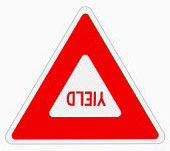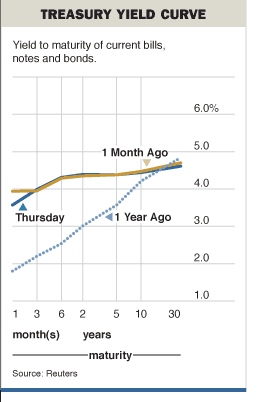
In Daniel Gross’ [The Dread “Inverted Yield Curve” – It makes brave economists cower [Slate]](http://www.slate.com/id/2133458/?nav=fo) he counters the concerns made over the yield curve as the result of “rigid thinking.”
A) rising interest rates and higher energy prices are poison for the economy.
B) an inverted yield curve signals recession
The former was disproved in 2005. Short-term interest rates rose sharply as the Federal Reserve continued to hike rates at every opportunity it had, and energy prices continued to climb. Yet the economy grew at a healthy clip…
In theory, an inverted yield curve means that investors and the Federal Reserve are fretting about inflation in the short term, and that investors are pessimistic about long-term growth. The combination of slow growth and high inflation is often deadly.
“You have to look at a broad array of leading indicators and see if there’s a consensus,” he said. And the consensus—among economists and among leading indicators—doesn’t signal that anything close to a recession is in the offing.
As a group, for example, the 56 economists polled by the Wall Street Journal in November believe growth will average 3.2 percent over the course of next year. That’s a slowdown from the current rate of growth but nowhere near a recession…Not a single economist of the group forecasts negative growth for any quarter.”
Here is some other commentary on the Inverted Yield Curve.
The post [Who’s afraid of the big bad yield curve? [Econbrowser]](http://www.econbrowser.com/archives/2005/12/whos_afraid_of.html) explains why we did get an inversion.
>The short rate has been rising rapidly because the Federal Reserve is concerned about
>inflation and has been raising rates to slow the economy. The longer term yields fell
>this month because investors’ expectations of both inflation and the level of economic
>activity likely slipped a bit, along with a possible decline in the term premium. All of
>these factors usually suggest the likelihood of a slowdown in economic activity.”

The WSJ article [Examining an Inversion](http://online.wsj.com/article_print/SB113528182051629707.html) discusses this issue with three noted economists, two of them from Swiss RE provided these comments on housing as it relates to the inverted yield curve.
>An inverted curve tends to be associated with economic weakness.
>But there are few such signs right now. Industrial production is
>rising, manufacturing activity is expanding, business spending
>on capital equipment is up; housing permits are climbing and
>unemployment is falling, among other strong trends.
>Strong corporate balance sheets today provide enough funds for
> investment even if consumer spending softens because of a
> moderating housing market.
As far as the housing markets go, if you subscribe to the argument that the brief inversion of the yield curve does not assure a recession, then all is sort of ok. The economy is expected to drag this year no matter what you think of the inversion, which would be expected to keep mortgage rates in check or see modest gains at best as long term rates remain historically low. However, the wild card is jobs and corporate profits. If the economy slows too much, then personal incomes and job creation will suffer and housing will not provide the offset to keep the economy moving due the potential for rising mortgage rates.
One Comment
Comments are closed.


Nothing lasts forever and neither will the inverted yield curve. I am placing money in stocks that will do well in a reversal of the curve. FBR for one.